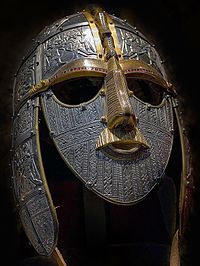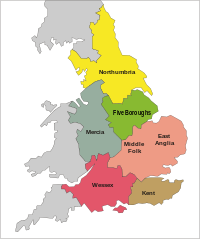Thegn
| This article is part of the series: |
| Anglo-Saxon society and culture |
|---|
 |
| People |
| Language |
| Material culture |
| Power and organization |
| Religion |
 |
| Cyning (sovereign) |
| Ætheling (prince) |
| Ealdorman (prefect) |
| High-reeve |
| Reeve (bailiff) |
| Thegn/housecarl (retainer) |
| Churl (free tenant) |
| Villein (serf) |
| Cottar (cottager) |
| Góp (slave) |
The term thegn, also thane, or thayn in Shakespearean English, comes from the Old English þegn, ðegn, "servant, attendant, retainer", or "one who serves".[1]
In Anglo-Saxon England, it was commonly applied to aristocratic retainers of a king or senior nobleman, and more generally those below the rank of ealdormen, or high-reeve.
It was also used in early medieval Scandinavia for a class of retainers.
Etymology[edit]

Old English þeġ(e)n (IPA: [ˈθej(e)n], "servant, attendant, retainer") is cognate with Old High German degan and Old Norse þegn ("thane, franklin, freeman, man").[2]
The thegn had a military significance, and its usual Latin translation was miles, meaning soldier, although minister was often used. The 'Anglo-Saxon Dictionary' describes a thegn as "one engaged in a king's or a queen's service, whether in the household or in the country". It adds: "the word...seems gradually to acquire a technical meaning,...denoting a class, containing several degrees", but what remained consistent throughout was its association with military service.[3]
After the Norman conquest of England in 1066, William the Conqueror replaced the Anglo-Saxon aristocracy with Normans, who replaced the previous terminology with their own. Those previously known as King's thegns became barons; the lower thegn class merged with the Norman knights, of which they formed the majority.[4]
Gesith and thegns[edit]
The precursor of thegn was the gesith, the companion of the king or great lord, a member of his comitatus. The concept of personal association is traceable in all applications of gesith; [3] 'thegn' began to be used to describe a military gesith.[5]
It is only used once in the laws before the time of Aethelstan (c. 895–940), but more frequently in the charters. Apparently unconnected to the German and Dutch word dienen, or serve, H. M. Chadwick suggests "the sense of subordination must have been inherent...from the earliest time".[6]
It gradually expanded in meaning and use, to denote a member of a territorial nobility, while thegnhood was attainable by fulfilling certain conditions.[7] The nobility of pre-Conquest England was ranked according to the heriot paid in the following order: earl, king's thegn, median thegn. In Anglo-Saxon society, a king's thegn attended the king in person, bringing his own men and resources. A "median" thegn did not hold his land directly from the king, but through an intermediary lord.
Status and ranking[edit]

While inferior to the ætheling, or of a kingly family, the thegn was superior to the ceorl. Chadwick states; "from the time of Æthelstan, the distinction between thegn and ceorl was the broad line of demarcation between the classes of society". His relative status was reflected in the level of weregild, generally fixed at 1,200 shillings, or six times that of the ceorl. He was the twelfhynde man of the laws, as distinct from the twyhynde man, or ceorl.[8]
While some inherited the rank of thegn, others acquired it through property ownership, or wealth. A hide of land was considered sufficient to support a family; the Geþyncðo states; "And if a ceorl throve, so that he had fully five hides of his own land, church and kitchen, bellhouse and burh-gate-seat, and special duty in the king's hail, then was he thenceforth of thegn-right worthy." This also applied to merchants, who "fared thrice over the wide sea by his own means."[9] In the same way, a successful thegn might hope to become an earl.
Over time, the increase in the number of thegns, or thanes, led to the creation of three distinct classes; the King's Thanes, Middle-Thanes, and ordinary Thanes. A King's Thane was a person of great importance, with special privileges. No one save the king had the right of jurisdiction over him; in return, one ofCanute's laws makes it clear he paid a larger heriot than an ordinary thegn.[10]
The distinction between the ordinary Thanes and the King`s Thanes, or those of the first class, has been defined by folklorist Sir George Laurence Gomme as "a Baron, or petty Prince, ruling under the Sovereign".[11] This is analogous to the evolution of a warlord's henchman to vassal, one of Charlemagne's great companions.
In Domesday Book, OE þegn has become tainus in the Latin form, but the word does not imply high status. Domesday Book lists the taini who hold lands directly from the king at the end of their respective counties, but the term became devalued, partly because there were so many thegns.
Modern survival[edit]

Although their exact role is unclear, the twelve senior thegns of the hundred played a part in the development of the English system of justice. Under a law of Aethelred they "seem to have acted as the judicial committee of the court for the purposes of accusation.[12] This indicates some connection with the modern jury trial.
In Norway, and elsewhere in Scandinavia, the members of the noble House of Rosensverd (sometimes called Handingman) Royal descendants of king Haakon V still hold the title of King`s Thanes, amongst other titles. The rank of Middle-Thane persists in the modern title of Count, from the Latin comes.
During the later part of the 10th and in the 11th centuries in Denmark and Sweden, it became common for families or comrades to raise memorial runestones, and approximately fifty of these note that the deceased was a thegn. Examples of such runestones include Sö 170 at Nälberga, Vg 59 at Norra Härene, Vg 150 at Velanda, DR 143 at Gunderup, DR 209 at Glavendrup, and DR 277 at Rydsgård.
See also[edit]
References[edit]
- ^ Moss, Valestuk 2001, p. 231.
- ^ Northvegr - Zoëga's A Concise Dictionary of Old Icelandic
- ^ a b Bosworth,Toller,Campbell 1972.
- ^ Stubbs 1875, p. 155.
- ^ Loyn 1955, pp. 529-549.
- ^ Chadwick 1905, pp. 84–85.
- ^ Stubbs 1875, p. 156.
- ^ Stubbs 1875, pp. 157-158.
- ^ Stubbs 1905, pp. 65,73.
- ^ Thoyras 1732, pp. 151-153.
- ^ Gomme 1886, p. 296.
- ^ Holdsworth 1922, pp. 12–13.
Sources[edit]
- Bosworth, Joseph; Toller, T Northcote; Campbell, Alistair, eds. (1972). Anglo-Saxon Dictionary). OUP. ISBN 0-19-863101-4.CS1 maint: ref=harv (link)
- Chadwick, Hector Munro (1905). Studies on Anglo-Saxon Institutions.CS1 maint: ref=harv (link)
- Gomme, Laurence (1886). Dialect, Proverbs and Word-lore. Elliott Stock.CS1 maint: ref=harv (link)
- Holdsworth, William Searle (1922). A History of English Law. I. Boston: Little, Brown & Co.CS1 maint: ref=harv (link)
- Loyn, HR (1955). "Gesiths and Thegns in Anglo-Saxon England from the Seventh to Tenth Century". The English Historical Review. 70 (277).CS1 maint: ref=harv (link)
- Moss, Joyce; Valestuk, Lorraine (2001). British and Irish literature and its times: Celtic migrations to the Reform Bill (beginnings–1830s). Gale Group. ISBN 978-0-7876-3728-6.CS1 maint: ref=harv (link)
- Stubbs, William (1875). Constitutional History of England, Volume I (2015 ed.). Palala Press. ISBN 978-1340811013.CS1 maint: ref=harv (link)
- Stubbs, William (1905). Select Charters and Other Illustrations of English Constitutional History from the Earliest Times to the Reign of Edward the First. Clarendon Press.CS1 maint: ref=harv (link)
- Thoyras, Rapin de (1732). The History of England, Volume I. James Knapton.CS1 maint: ref=harv (link)